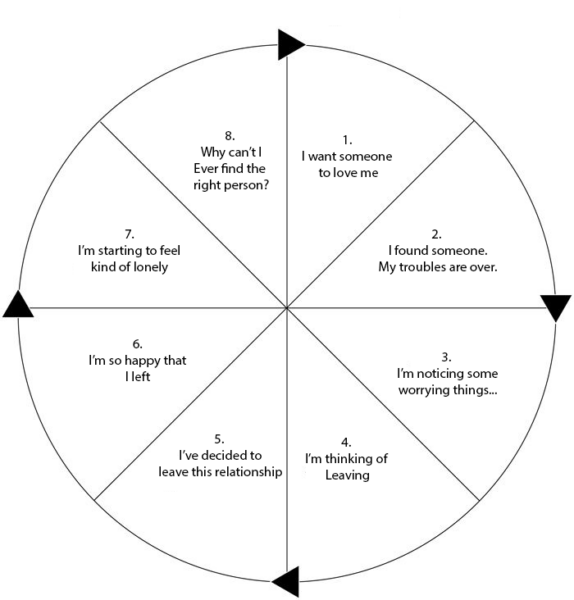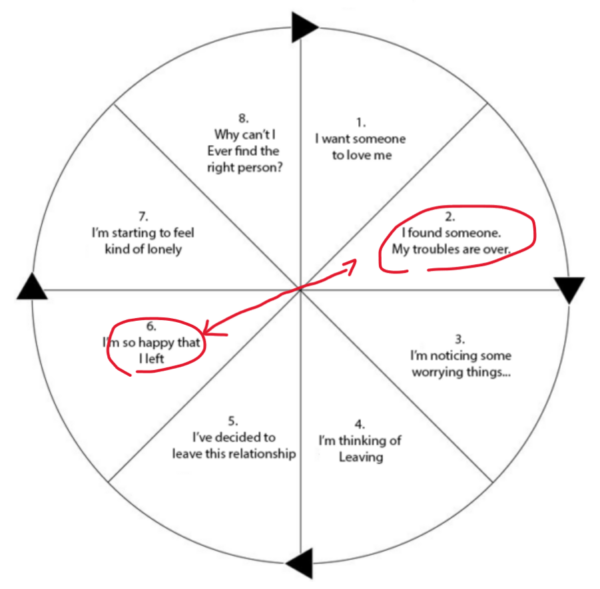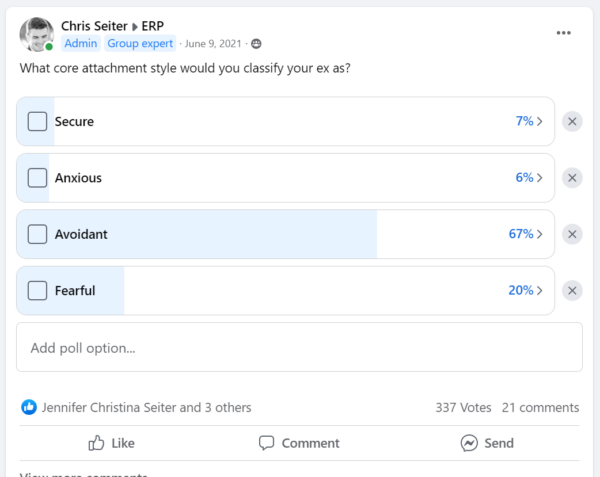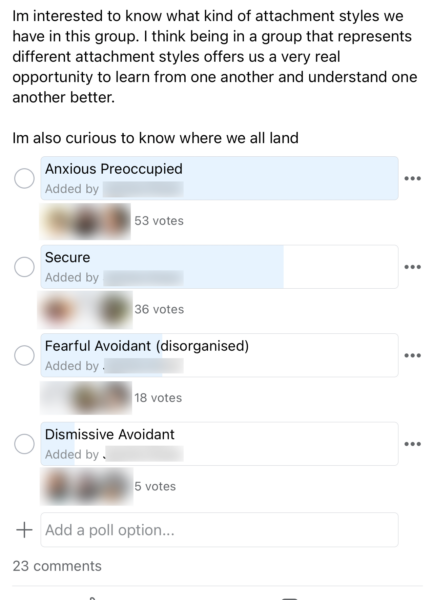In my opinion there are six main ways that I’ve seen avoidants treat their ex.
Technically speaking everything with an avoidant boils down to their core wound. They are terrified of losing their independence and so when they sense that’s happening they are likely to react in a way that safeguards that.
This is how you get this type of behavior,
- No Closure Seeking
- The Separation Elation Phase
- Grow Depressed In The Loneliness
- Don’t Miss Their Ex Until They Believe There Is No Chance
- A Resistance To Dependency
- The Phantom Ex
Let’s begin!

What Are Your Chances of Getting Your Ex Boyfriend Back?
Take the quiz1) No Closure Seeking:
Unlike many other attachment styles that seek closure or a final talk before parting ways, avoidants don’t.
They don’t need a final understanding of why the relationship ended. They’re not going to pursue or desire it.
Many people in our community are constantly seeking closure from their exes,
I think one of the reasons avoidants specifically struggle with providing closure is that it’s really tied to their pattern of emotional distancing and self-preservation.
They’re very uncomfortable with emotions and they avoid conflict. But remember, what they care more about is their independence. This is a core wound that they keep returning to throughout their lives. Discussing a failed relationship brings them back to the past, which they dislike.
They don’t like any sign of emotional dependency.
When avoidants have to talk to their ex about what went wrong in the relationship and what could have been done better, there’s a sense of emotional dependency—that they are responsible for making you feel better, and they want to avoid that at all costs.
But I also think there’s a misunderstanding of the value of closure.
For someone with an anxious attachment style, closure can be quite helpful to help them close that chapter of their lives and move on. An avoidant doesn’t necessarily view closure in the same way.
They probably don’t fully understand its value for themselves or their partners and consistently think of it as an unnecessary thing to provide. It’s all rooted in self-protection.
By not providing closure, they protect themselves from fully engaging with any emotional implications that come with the end of a relationship, which they probably understand can be an incredibly painful process. This makes them seem particularly cold to their partners and gives them a sort of one-and-done mentality. So, don’t expect a dismissive avoidant to seek closure anytime soon.
2) The Separation Elation Phase:
For this, I think we really need to discuss the “avoidant death wheel” graphic that I consistently promote in many of my articles.
The avoidant death wheel is my attempt to visualize the patterns that avoidants tend to exhibit in relationships.
There are eight main stages.
- They start off wanting someone to love them.
- Then they enter into a relationship and believe that their troubles are over, also known as the honeymoon period.
- Then they start noticing some worrying things.
- These concerns lead them to think about leaving the relationship.
- Eventually, they decide to leave.
- After leaving, they feel overjoyed about their decision.
- Then they start to feel kind of lonely.
- This loneliness turns into depression, which ultimately leads them back to the beginning.
The thing about dismissive avoidants is that they’re caught in this loop consistently, time and time again, and it can be difficult for them to break out of it.
However, what many may miss about this visual graphic is that there are actually two honeymoon periods.

What Are Your Chances of Getting Your Ex Boyfriend Back?
Take the quizThere’s stage two, the “I found someone, my troubles are over” phase, the traditional honeymoon period you would expect.
But there’s also stage six, the “I’m so happy I left that relationship” phase, also known as the separation elation phase.
To understand the separation elation associated with this graphic, we must first understand the avoidant’s core wound, which always revolves around independence.
They want to maintain their independence at all costs.
Yet, when they’re in a relationship, they start to feel as if their independence is being encroached upon. Ultimately, after ending the relationship, they feel like they’re regaining their independence, which brings a sense of relief—a weight lifted off their shoulders.
This is all about the honeymoon period revolving around reclaiming their independence.
What’s also interesting is that they get these positive hits in both stage two and stage six, which almost keeps them perpetually tied to this death wheel. They seek the emotional high of the honeymoon period and the emotional high of regaining their independence.
Thus, they continue to jump from one relationship to another, often in an on-again, off-again fashion, all revolving around the separation elation and the two honeymoon periods.
3) Grow A Little Depressed In The Loneliness
If you refer to the graphic I discussed above, the “avoidant death wheel,”
You’ll notice that, for the most part, loneliness and depression set in after the separation elation phase.
What’s interesting about dismissive avoidants is that they are kind of like walking contradictions.
They start off wanting love, desiring closeness with someone, only to realize that they dislike the amount of vulnerability and independence they have to sacrifice to maintain a strong relationship. This usually means that after they go through a breakup, they convince themselves during the separation elation phase that it was the right decision. But over time, their innate desire to be with someone resurfaces, and they grow a little depressed.
This is often the stage when nostalgic reverie kicks in, and they start to romanticize the past.
We’ll talk a bit more about that shortly.
But to give you an analogy, I was watching this really horrible TV show the other day called “Farmer Wants a Wife.”
Ridiculous, I know—feel free to judge me. However, I found the premise of the show quite interesting: you have four farmers, people who run ranches and don’t really have a lot of free time, mostly spending it alone.
I’m not going to outright say that they’re avoidant, but their lifestyle certainly sets them up for solitude. Each of these farmers wants a wife; they want someone to share their life with. They’ve realized, especially as they hit their mid to late 30s, that while they may have cherished their independence, the reality of being alone terrifies them. They work hard on their ranches, doing all this farming stuff, with no one to come home to, leading to a robotic and almost depressing existence.
This is how I view dismissive avoidants.
There are various ways they try to cope with this loneliness. Sometimes they’ll jump into a relationship immediately because they’ve learned that this temporarily stops the pain—it’s almost a distraction.
Sometimes they’ll re-enter a relationship with you, but they’ll always do everything they can to avoid feeling that loneliness and depression. They find distractions to keep these feelings at bay.
They Don’t Tend To Miss Their Ex Until They Believe There’s No Chance:
A couple of years ago, I filmed a video that I am proud of.
(Though between you and I, I want to create an updated version that is better filmed.)

What Are Your Chances of Getting Your Ex Boyfriend Back?
Take the quizThe title of the video was “How to Make an Avoidant Ex Miss You.”
I ran a poll a few years back and found that most of the clients who pay me to help them through their breakups had exes who tended to be dismissive avoidants.
So, I wanted to make a video to help people understand how avoidants view the world.
One of the key insights from my research on avoidants is that they don’t tend to allow themselves the opportunity to miss someone until they feel as if the other person is safe. The ideal relationship for an avoidant is one where there are no repercussions and their independence isn’t threatened. They actually prefer to admire people from afar.
What often happens with an avoidant is that they don’t usually allow themselves to romanticize the past until they see you moving on, or enough time has passed. This is one of the reasons I point out to people when they ask, “Why is it that just when I start to move on, my ex comes back into the picture and texts me after a year?”
It could very well be that this is the period when your ex is tapping into this nostalgic reverie.
One of the ways that I’ve found avoidant exes treat their exes is by texting them out of the blue after months have gone by, when you think there’s no chance. This is because this is the time when they feel safe to do so.
They feel as if now they’re allowed to romanticize the past.
A Resistance To Dependency
Avoidants, in general, are likely to resist any signs of dependency from their ex, such as requests for help or emotional support.
This is essentially the PTSD of the anxious attachment.
Our internal polling indicates that our average client tends to have an anxious attachment style,
While their ex tends to have an avoidant attachment style,
This creates a pairing of oil and water.
The anxious person constantly needs reassurance, while the avoidant person does not want to give reassurance.
In the relationship, the anxious person is often asking the avoidant for more time together or for expressions of love, essentially seeking some form of reassurance. However, the avoidant interprets these requests as an assault on their independence, which pushes them away.
This is why we’ve established a rule for many of our clients when interacting with their avoidant exes: when they pull back, you pull back. This approach works particularly well because it speaks the avoidant’s language.
It gives the avoidant the reassurance they need that you’re not there to intrude upon their independence. The avoidant’s resistance to dependency stems from the PTSD they have from dating people with an anxious attachment style.
Ultimately, everything we’re discussing here, every way that they treat you, hooks back into their core wound. Anything that makes the avoidant feel as if they’re losing their independence will trigger them and cause them to exhibit avoidant behavior.
Paint You As A Phantom Ex
An avoidant individual may idealize a past partner as the “one that got away,” creating a narrative of a perfect but unfulfilled relationship.

What Are Your Chances of Getting Your Ex Boyfriend Back?
Take the quizThis idealization often overlooks the reality of the relationship’s shortcomings, such as lack of intimacy, communication, and genuine connection, which might have actually prevented their avoidant defenses from being triggered.
Over time, the distance from this “phantom ex” allows the avoidant to romanticize the past, remembering only the positives and convincing themselves that this ex was their best partner, while ignoring why the relationship ended. This idealization can interfere with forming new, close relationships, as new partners may seem less appealing in comparison to the glorified ex.
I talk about this extensively in my video on phantom exes,
Avoidants may believe they desire closeness, but this fixation on a past partner is a subconscious strategy to maintain emotional distance. If they were to reconnect with the phantom ex and the relationship progressed to a stable phase, it’s likely their avoidant tendencies would resurface.
In essence, avoidants remember the positives of past relationships while ignoring the negatives, a process known as romanticizing. This can strain new relationships, as they maintain an emotional distance by focusing on the idealized past rather than the present connection.




